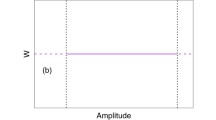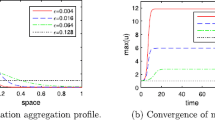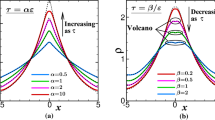Abstract
We consider the two dimensional parabolic-elliptic Keller–Segel model of chemotactic aggregation for radially symmetric initial data. We show the existence of a stable mechanism of singularity formation and obtain a complete description of the associated aggregation process.
Similar content being viewed by others
Notes
Which is reflected by the weakness of the a priori information (1.3) for mass super critical initial data.
Note that it can be the case that the addition of directions of freedom dramatically perturb the mechanism of energy concentration, see [33].
i.e. Slowly decaying zeroes.
This is a technical unpleasant problem which directly relates to the slow decay of \(Q\) at infinity. Similar issues already occurred in related settings, see for example [21].
Following the celebrated proof by Weinstein [44] for nonlinear Schrödinger equations.
This is due to the fact that the non linear equation satisfied by the partial mass of \(Q_b\) is invariant by \(m(r)\mapsto m(\lambda r)\), see (3.8), and indeed \(\psi _0\in \hbox {Span} \{rm'_Q\}\), \(m_Q(r)=\int _0^rQ(\tau )\tau d\tau \).
Recall that the only radially symmetric harmonic function in \(R^2\) is \(\mathrm{log}r\) which is singular at the origin.
We need to prove that \(\phi =\phi _u\).
Working with \(\varepsilon _n\in {\mathcal {C}}^{\infty }(\mathbb {R}^2)\) ensures that \(\phi _{\varepsilon _n}\) makes sense while only \(\nabla \phi _\varepsilon \) is well defined for \(\varepsilon \in {\mathcal {E}}\), and we may thus recover a Hardy type control on \(\phi _{\varepsilon _n}\) from (8.3).
Recall that \(\varepsilon _n=\Delta \phi _{\varepsilon _n}\).
This structure is reminiscent from the parabolic heat flow problem and one could show that this operator can be factorized \(L_0=A_0^*A_0\) where the adjoint is taken against \(\frac{(1+r^2)^2}{r}dr\) and \(A_0\) is first order, and this explains why all formulas are explicit.
Equivalently, one should observe that the \(T_2\) equation is forced by \(\Lambda T_1\) which enjoys the improved decay at infinity \(\Lambda T_1=O(\frac{|\mathrm{log}r|^2}{r^4})\), see [38] for related phenomenons.
The worst term is \(b^3rm'_2\).
See for example [20] for a complete proof in a related setting.
We will show that the rescaled time is global \(s(t)\rightarrow +\infty \) as \(t\rightarrow T\).
Which correspond to the factorization of the linearized operator \({\mathcal {L}}\) in two operators of order one: \({\mathcal {L}}=\nabla \cdot (A)\).
Which is a consequence of the \(L^1\) critical identity \(\int \Lambda Q=0\).
Which corresponds to an improved decay at infinity, as indeed each term in the left hand side of (5.43) is decaying too slowly at infinity to be treated separately.
For which a better bound than for \(\Vert \varepsilon _2\Vert _{L^2_Q}\) holds in time averaged sense.
References
Beckner, W.: Sharp Sobolev inequalities on the sphere and the Moser–Trudinger inequality. Ann. Math. 2(138), 213–242 (1993)
Van den Berg, G.J.B., Hulshof, J., King, J.: Formal asymptotics of bubbling in the harmonic map heat flow. SIAM J. Appl. Math. 63(5), 1682–1717 (2003)
Bejenaru, I., Tataru, D.: Near soliton evolution for equivariant Schroedinger Maps in two spatial dimensions. arXiv:1009.1608 (2011)
Biler, P., Karch, G., Laurencot, P., Nadzieja, T.: The 8\(\pi \)-problem for radially symmetric solutions of a chemotaxis model in the plane. Math. Methods Appl. Sci. 29(13), 1563–1583 (2006)
Blanchet, A., Carrillo, J., Carlen, E.: Functional inequalities, thick tails and asymptotics for the critical mass Patlak–Keller–Segel model. arXiv:1009.0134 (2011)
Blanchet, A., Carrillo, J., Masmoudi, N.: Infinite time aggregation for the critical Patlak–Keller–Segel model in \(\mathbb{R}^2\). Comm. Pure Appl. Math. 61, 144–1481 (2008)
Blanchet, A., Dolbeault, J., Perthame, B.: Two-dimensional Keller–Segel model: optimal critical mass and qualitative properties of the solutions. Electron. J. Differ. Equ. 44 (2006)
Brezis, H.: Analyse fonctionnelle. Théorie et applications. In: Collection Mathématiques Appliquées pour la Maîtrise. Masson, Paris (1983)
Carlen, E., Figalli, A.: Stability for a GNS inequality and the Log-HLS inequality, with application to the critical mass Keller–Segel equation. arXiv:1107.5976
Carlen, E., Loss, M.: Competing symmetries, the logarithmic HLS inequality and Onofri\(\tilde{O}\)s inequality on Sn. Geom. Funct. Anal. 2, 9–104 (1992)
Dejak, S.I., Lushnikov, P.M., Ovchinnikov, Yu. N., Sigal, I.M.: On Spectra of Linearized Operators for Keller–Segel Models of Chemotaxis. arXiv:1110.6393 (2011)
Diaz, J., Nagai, T., Rakotoson, J.M.: Symmetrization techniques on unbounded domains: application to a chemotaxis system on \(\mathbb{R}^N\). J. Differ. Equ. 145, 156–183 (1998)
Gustafson, S., Nakanishi, K., Tsai, T.-P.: Asymptotic stability, concentration and oscillations in harmonic map heat flow, Landau Lifschitz and Schrödinger maps on \(\mathbb{R}^2\). Commun. Math. Phys. 300(1), 205–242 (2010)
Herrero, M.A., Velázquez, J.J.L.: Singularity patterns in a chemotaxis model. Math. Ann. 306(3), 58–623 (1996)
Herrero, M.A., Velázquez, J.J.L.: A blow-up mechanism for a chemotaxis model. Ann. Scuola Norm. Sup. Pisa Cl. Sci. 24(4), 633–683 (1997)
Kavallaris, N., Souplet, Ph.: Grow up rate and refined asymptotics for a two dimensional Patlak-Keller-Segel model in a disk. SIAM J. Math. Anal. 40(5), 1852–1881 (2009)
Keller, E.F., Segel, L.A.: Initiation of slime mold aggregation viewed as an instability. J. Theor. Biol. 26, 399–415 (1970)
Landman, M.J., Papanicolaou, G.C., Sulem, C., Sulem, P.-L.: Rate of blowup for solutions of the nonlinear Schrödinger equation at critical dimension. Phys. Rev. A (3) 38(8), 3837–3843 (1988)
Lemou, M., Méhats, F., Raphaël, P.: Structure of the linearized gravitational Vlasov–Poisson system close to a polytropic ground state. SIAM J. Math. Anal. 39(6), 1711–1739 (2008)
Martel, Y., Merle, F.: Instability of solitons for the critical generalized Korteweg–de Vries equation. Geom. Funct. Anal. 11(1), 7–123 (2001)
Martel, Y., Merle, F.: Blow up in finite time and dynamics of blow up solutions for the \(L^2\) critical generalized KdV equation. J. Am. Math. Soc. 15(3), 61–664 (2002)
Martel, Y., Merle, F., Raphaël, P.: Blow up for the critical gKdV equation I: dynamics near the soliton. arXiv:1204.4625 (2012)
Martel, Y., Merle, F., Raphaël, P.: Blow up for the critical gKdV equation II: minimal mass dynamics, arXiv:1204.4624 (2012)
Martel, Y., Merle, F., Raphaël, P.: Blow up for the critical gKdV III: blow up for the critical gKdV equation III: initial data with slow decay (2014, in preparation)
Matano, H., Merle, F.: Classification of type I and type II behaviors for a supercritical nonlinear heat equation. J. Funct. Anal. 256(4), 992–1064 (2009)
Matano, H., Merle, F.: On nonexistence of type II blowup for a supercritical nonlinear heat equation. Commun. Pure Appl. Math. 57(11), 1494–1541 (2004)
Merle, F., Raphaël, P.: Blow up dynamic and upper bound on the blow up rate for critical nonlinear Schrödinger equation. Ann. Math. 161(1), 157–222 (2005)
Merle, F., Raphaël, P.: Sharp upper bound on the blow-up rate for the critical nonlinear Schrödinger equation. Geom. Funct. Anal. 13(3), 59–642 (2003)
Merle, F., Raphaël, P.: On universality of blow-up profile for L2 critical nonlinear SchrẐdinger equation. Invent. Math. 156(3), 56–672 (2004)
Merle, F., Raphaël, P.: Sharp lower bound on the blow up rate for critical nonlinear Schrödinger equation. J. Am. Math. Soc. 19(1), 37–90 (2006)
Merle, F., Raphaël, P.: Profiles and quantization of the blow up mass for critical nonlinear Schrödinger equation. Commun. Math. Phys. 253(3), 675–704 (2005)
Merle, F., Raphaël, P.: On one blow up point solutions to the critical nonlinear Schrödinger equation. J. Hyperbolic Differ. Equ. 2(4), 919–962 (2005)
Merle, F., Raphaël, P., Rodnianski, I.: Blow up dynamics for smooth equivariant solutions to the energy critical Schrödinger map. C. R. Math. Acad. Sci. Paris 349(5–6), 279–283 (2011)
Mizoguchi, N.: Rate of type II blowup for a semilinear heat equation. Math. Ann. 339(4), 83–877 (2007)
Nagai, T.: Behavior of solutions to a parabolic-elliptic system modelling chemotaxis. J. Korean Math. Soc. 37(5), 721–733 (2000)
Patlak, C.S.: Random walk with persistence and external bias. Bull. Math. Biophys. 15, 311–338 (1953)
Perthame, B., Vasseur, A.: Regularization in Keller–Segel type systems and the De Giorgi method (2012, preprint). http://www.ma.utexas.edu/users/vasseur/publications.html
Raphaël, P., Rodnianski, I.: Stable blow up dynamics for the critical co-rotational Wave Maps and equivariant Yang–Mills problems. Pub. Math IHES (2011, to appear)
Raphaël, P., Schweyer, R.: Stable blow up dynamics for the 1-corotational energy critical harmonic heat flow. Commun. Pure Appl. Math. (2011, to appear)
Raphaël, P., Schweyer, R.: Quantized slow blow up dynamics for the corotational energy critical harmonic heat flow (2014, submitted)
Rodnianski, I., Sterbenz, J.: On the formation of singularities in the critical \(O(3)\) \(\sigma \)-model. Ann. Math. 172(2), 187–242 (2010)
Velázquez, J.J.L.: Stability of some mechanisms of chemotactic aggregation. SIAM J. Appl. Math. 62(5), 158–1633 (2002)
Velázquez, J.J.L.: Singular solutions of partial differential equations modelling chemotactic aggregation. In: Proceedings of the ICM (2006). http://www.icm2006.org/proceedings/vol3.html
Weinstein, M.I.: Modulational stability of ground states of nonlinear Schrödinger equations. SIAM J. Math. Anal. 16, 472–491 (1985)
Acknowledgments
The authors would like to thank A. Blanchet, J. Dolbeaut and P. Laurencot for their interest and support during the preparation of this work. The authors would also like to thank the anonymous referees for their careful reading of the paper. Part of this work was done while P.R was visiting the MIT Mathematics department which he would like to thank for its kind hospitality. This work is supported by the ERC/ANR grant SWAP and the advanced ERC grant BLOWDISOL.
Author information
Authors and Affiliations
Corresponding author
Appendices
Appendix A: Estimates for the Poisson field
This appendix is devoted to the derivation of linear estimates, in particular for the Poisson field in \(H^2_Q\) and \({\mathcal {E}}\). We start with weighted \(H^2\) type bounds:
Lemma 7.1
(\(H^2\) bound) Let \(p=1,2\), then for all \(u\in {\mathcal {D}}(\mathbb {R}^2)\),
Proof of Lemma 7.1
We integrate by parts to compute:
and similarly with \(x_2\), and (7.1) follows.\(\square \)
We now turn to the linear control of the Poisson field:
Lemma 7.2
(Estimates for the Poisson field) There holds the bounds on the Poisson field:
-
(i)
General \(L^2_Q\) bounds:
$$\begin{aligned}&\displaystyle \Vert (1+|\mathrm{log}r|)u\Vert _{L^1}+\Vert \phi _u\Vert _{L^{\infty }(r\le 1)}+\left\| \frac{|\phi _u|}{1+|\mathrm{log}r|}\right\| _{L^{\infty }(r\ge 1)}\lesssim \Vert u\Vert _{L^2_Q},\end{aligned}$$(7.2)$$\begin{aligned}&\displaystyle \Vert \nabla \phi _u\Vert _{L^4}\lesssim \Vert u\Vert _{L^2_Q}.\qquad \end{aligned}$$(7.3) -
(ii)
Improved \(L^2_Q\) bound: if moreover \(\int u=0\), then:
$$\begin{aligned} \Vert \phi _u\Vert _{L^{\infty }}&\lesssim \Vert u\Vert _{L^2_Q},\end{aligned}$$(7.4)$$\begin{aligned} \int |\nabla \phi _u|^2&= -\int u\phi _u\lesssim \Vert u\Vert ^2_{L^2_Q}. \end{aligned}$$(7.5) -
(iii)
Energy bound:
$$\begin{aligned} \forall 1\le p<2,\quad \Vert \nabla \phi _u\Vert _{L^{\infty }}\le C_p\Vert u\Vert ^{1-\frac{p}{2}}_{L^{\infty }}\Vert u\Vert _{L^2}^{p-1}\Vert u\Vert ^{1-\frac{p}{2}}_{L^1}. \end{aligned}$$(7.6) -
(iv)
Decay in the energy space: \(\forall 0\le \alpha <1\),
$$\begin{aligned} |u(x)|&\le C_{\alpha } \frac{\Vert u\Vert _{{\mathcal {E}}}}{1+|x|^\alpha },\end{aligned}$$(7.7)$$\begin{aligned} |\nabla \phi _u(x)|&\le C_{\alpha } \frac{\Vert u\Vert _{{\mathcal {E}}}}{1+|x|^{\frac{\alpha }{2}}}. \end{aligned}$$(7.8)
Proof of Lemma 7.2
Proof of (i)–(ii): By Cauchy–Schwarz:
For \(|x|\le 1\), we estimate using Cauchy–Schwarz:
For \(|x|\ge 1\), we rewrite
For the outer term, we estimate:
On the singularity, we estimate using a simple change of variables:
and this concludes the proof of (7.2) and (7.4).
We then estimate from the 2 dimensional Hardy–Littlewood–Sobolev and Hölder:
and (7.3) is proved. Let a smooth cut off function \(\chi (x)=1\) for \(|x|\le 1\), \(\chi (x)=0\) for \(|x|\ge 2\), and \(\chi _R(x)=\chi (\frac{x}{R})\), then from (7.4):
with constants independent of \(R>0\), and hence
Moreover, integrating by parts:
From (7.10), we can find a sequence \(R_n\rightarrow \infty \) such that
and then from (7.4):
and thus
The estimate (7.5) now follows from (7.4).
Proof of (iii): Let \(1\le p<2\), we estimate in brute force:
We optimize in \(R\) and interpolate:
this is (7.6).
Proof of (iv): By density, it suffices to prove (7.7) for \(u\in {\mathcal {D}}(\mathbb {R}^2)\). Let \((v_{i,j}=x_i\partial _ju)_{1\le i,j\le 2}\), we estimate from (7.1) with \(p=2\):
and thus from Sobolev:
We now recall the standard Sobolev bound, see for example [8]:
We may find \(|a|\le 1\) such that
and hence the growth estimate:
We apply this to \(f_{i}=x_iu\) and conclude from (7.11), (9.4): \(\forall p>2\) and \(i=1,2\):
and hence the decay:
which yields (7.7).
Let \(0\le \alpha <1\) and \(|x|\gg 1\), we estimate the Poisson field in brute force using (7.7):
and (7.8) is proved.\(\square \)
Appendix B: Hardy bounds
We recall some standard weighted Hardy inequalities:
Lemma 8.1
(Weighted Hardy inequality) There holds the Hardy bounds:
Proof of Lemma 8.1
Let \(u\in {\mathcal {C}}^{\infty }_c(\mathbb {R}^2)\). We integrate by parts to estimate:
and (8.1) follows.
Let now \(\phi \in {\mathcal {D}}(\mathbb {R}^2)\) and consider the radial continuous and piecewise \({\mathcal {C}}^1\) function
then
and thus:
Now by Sobolev:
and thus
which implies (8.2).
Similarly, for \(r\ge r_0\) large enough:
and (8.3) follows again from Cauchy Schwarz and Sobolev.
This concludes the proof of Lemma 8.1.
Appendix C: Interpolation bounds
We collect in this appendix the bootstrap bounds on \(\varepsilon \) which are a consequence of the spectral estimates of Proposition 2.8 and further interpolation estimates.
Proposition 9.1
(Interpolation bounds) There holds:
-
(i)
\(H^2_Q\) bound:
$$\begin{aligned}&\int (1+r^4)|\nabla ^2\varepsilon |^2+\int (1+r^2)|\nabla \varepsilon |^2+\int \varepsilon ^2\nonumber \\&\quad +\int |\Delta \phi _\varepsilon |^2+\int \frac{|\nabla \phi _\varepsilon |^2}{r^2(1+|\mathrm{log}r|)^2}\lesssim C(M)\Vert \varepsilon _2\Vert _{L^2_Q}^2,\end{aligned}$$(9.1)$$\begin{aligned}&\int (1+r^2)|\varepsilon _1|^2\lesssim C(M)\Vert \varepsilon _2\Vert _{L^2_Q}^2. \end{aligned}$$(9.2) -
(ii)
\(L^{\infty }\) bounds:
$$\begin{aligned} \forall 0<\eta \le \frac{1}{2},\quad \Vert \nabla \phi _\varepsilon \Vert _{L^{\infty }}\le C_\eta \Vert \varepsilon _2\Vert ^{1-\eta }_{L^2_Q}, \end{aligned}$$(9.3)and \(\forall 0\le \alpha <\frac{1}{2}\),
$$\begin{aligned} \Vert (1+|x|^{\alpha })\varepsilon \Vert _{L^{\infty }}+\left\| (1+|x|^{\frac{\alpha }{2}})\nabla \phi _\varepsilon (x)\right\| _{L^{\infty }}\lesssim \delta (\alpha ^*). \end{aligned}$$(9.4) -
(iii)
\(H^2_Q\) bound with logarithmic loss:
$$\begin{aligned} \int (1+\mathrm{log}(1+r))^C\frac{|\nabla \phi _\varepsilon |^2}{r^2(1+|\mathrm{log}r|)^2}\lesssim |\mathrm{log}b|^C\left( \Vert \varepsilon _2\Vert _{L^2_Q}^2+b^{10}\right) , \end{aligned}$$(9.5) -
(iv)
\(L^{\infty }\) bound with loss:
$$\begin{aligned} \left\| \frac{\nabla \phi _\varepsilon }{1+|x|}\right\| ^2_{L^{\infty }}\lesssim |\mathrm{log}b|^C\left( \Vert \varepsilon _2\Vert _{L^2_Q}^2+b^{10}\right) . \end{aligned}$$(9.6) -
(v)
Weighted bound with loss:
$$\begin{aligned} \int \frac{|\varepsilon |}{1+r}\lesssim C(M)\sqrt{|\mathrm{log}b|}\Vert \varepsilon _2\Vert _{L^2_Q}+b^{10}. \end{aligned}$$(9.7)
Proof of Proposition 9.1
Proof of (i): The estimate (9.1) follows directly from (2.58), (2.60), our choice of orthogonality conditions (4.6) and (7.1) with \(p=2\). We then estimate from the definitions (5.36), (5.37) and (9.1):
Proof of (ii): Let \(p=2(1-\eta )\in [1,2)\), then from (7.6), Sobolev, (9.1) and the bootstrap bound (4.8):
The decay bound (9.4) follows from the interpolation bounds (7.7), (7.8), the \(H^2_Q\) bound (9.1) and the bootstrap bounds (4.8), (4.9).
Proof of (iii): The lossy bound (9.5) follows from (9.1), (9.4) with \(\alpha =\frac{1}{2}\). Indeed, let \(B=b^{-100}\), then:
Proof of (iv): From Sobolev:
Proof of (9.7): We use the global \(L^1\) bound (4.8), (9.1) and Cauchy Schwarz to estimate:
and (9.7) is proved.\(\square \)
Rights and permissions
About this article
Cite this article
Raphaël, P., Schweyer, R. On the stability of critical chemotactic aggregation. Math. Ann. 359, 267–377 (2014). https://doi.org/10.1007/s00208-013-1002-6
Received:
Revised:
Published:
Issue Date:
DOI: https://doi.org/10.1007/s00208-013-1002-6




